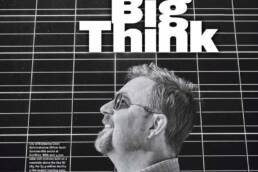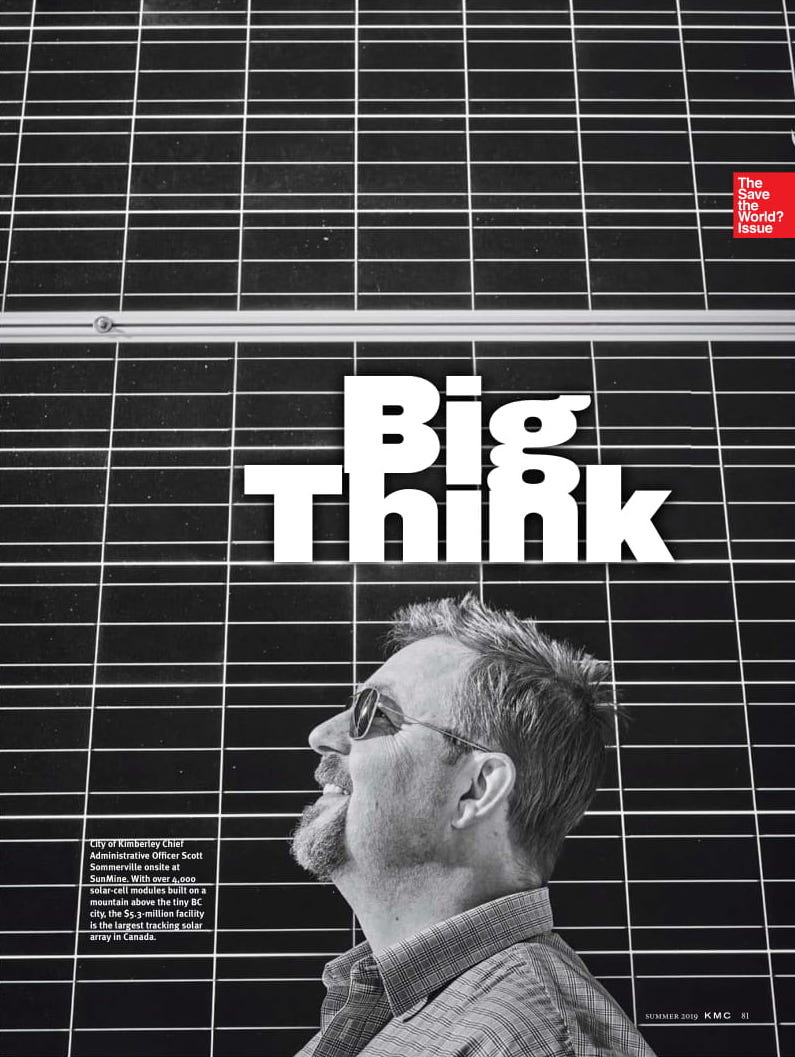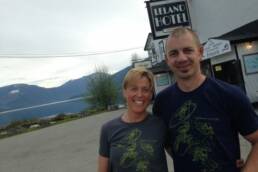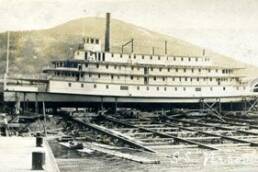Where some see the future as uncertain, or even imperilled, others see opportunity and hope. This Kootenay entrepreneur is boldly going where no plan has gone before, and he wants us all to come along. This story by Matt Coté first appeared in KMC’s Summer 2019 issue. Photos by Bryce Duffy.
Fire. It is one of the first technologies humans ever used. Long before we knew how to start it, we scampered to harness naturally occurring flames to keep our torches burning. Eventually, we learned how to make fire on a whim and how to control it. From that moment on, we learned the truth about technology: it can warm the house, or burn it down. While it’s been eons since we discovered that duality of innovation, it remains the same today.An axe can split wood, or cause you to lose a finger. A car can get you across town, or put you upside down in a ditch.The energy in an atom can power entire nations, or blow up the world. In the spirit of continuing this ongoing dance of techno-optimism, where we forever hang our hopes on our species’ ingenuity and benevolence, we bring you the Kootenays’ leading tech champions. They are tackling some of the world’s biggest problems caused by said tech, with incredibly techie solutions.
Scott Sommerville: City of Kimberley’s SunMine
From Netflix to furnaces, we live in an energy-craving world. Between 1990 and 2013, electrical demand in Canada increased by 28 per cent. In places like coal-powered Alberta, that’s a big problem for the climate. In British Columbia, however, almost all power comes from “green” hydroelectricity. The problem is, British Columbia is running out of rivers to dam.
“We were looking to fill future needs,” says Scott Sommerville, chief administrative officer of the City of Kimberley in southeast British Columbia. Under his direction, the city built Canada’s largest tracking solar array: the SunMine, whose 4,032 panels tilt throughout the day to follow the sun’s path for maximum exposure. Since 2015, the $5.3-million award-winning facility has been producing a gigawatt of electricity at peak daylight, in the hopes of growing a new local industry. “Particularly in the Kootenays, we’re really aware of the damage that happens when you flood arable land,” Sommerville says, noting one of the major impacts of damming our rivers. “Being born and raised in Nelson and having Russian heritage and knowing about how not just the Doukhobors but the First Nations were shuffled off the flood plains, I know we can’t grow crops on them anymore. Some of our best land has been used up. It’s the same thing they’re protesting at Site C.”
The Site C Dam is a controversial $9-billion dam on the Peace River near Fort St. John, British Columbia, that has angered many. The logic of the SunMine, on the other hand, was easy to get behind. Its location — the old concentrator site from the now-expired Sullivan Mine, which was the largest lead-zinc mine in the world for 100 years — was sitting empty, and the Canadian Rockies International Airport just outside Kimberley records the most sunny days per year in Canada, over 300. A solar farm was the perfect fit. “It’s come full circle,” Sommerville says. “We ran out of a resource our community was built upon, and somebody realized the sun is a resource. And we are loaded with it here.”
“We’ve got heaps of potential,” says Scott Sommerville. “SunMine could be 200 times bigger than it is right now.”
The SunMine currently has a contract with BC Hydro to double in size. But since the provincial government approved Site C in 2018, the utility company — which is a provincial monopoly — has lost nearly all interest in solar energy and isn’t encouraging the SunMine to expand anymore. The province predicts a 10,000 gigawatt-hour increase in power demand by 2050, much of it for liquid natural gas development. Site C represents one-ninth of that demand. Kimberley’s SunMine, as is, only represents one five-thousandth.
Meanwhile, a British Columbia-Alberta feud over the Trans Mountain Pipeline has killed plans for a better hydropower transmission line from the Kootenays to Alberta, which the SunMine was counting on to expand. In October 2018, the citizens of Kimberley decided to sell the SunMine to Teck, the company that owns the land, which is better positioned to continue the expansion without BC Hydro’s support. “We’ve got heaps of potential,” Sommerville still insists, proud of his baby. “SunMine could be 200 times bigger than it is right now, if we had a customer [wanting] that amount of power.”
This is the fourth in our series called “Big Think” celebrating technological entrepreneurs in the Kootenay region. Matt Coté is a technological agnostic based in Revelstoke, British Columbia. He believes if there is a second coming, it’ll be a robot.
Matt Coté
Matt is the associate editor at Forecast. He's been penning and editing ski, adventure and mountain culture-based stories for over a dozen publications for the last decade.
Related Stories
Kootenay Sufferfest
What tastes so good in there? We are stoked to announce that Kaslo Sufferfest kicks off this weekend, with record…
Kootenay Spirit Festival
It's time to get in touch with your spiritual side, Kootenays. Buy tickets to the Kootenay Spirit Festival now.
New Kootenay Bike Website
Ahhh, the wonders of Facebook. Check your news feed every once in a while and voila, one of your…
Sternwheelers of Kootenay Lake
Our Art Director loves his history. He recently found this very comprehensive site exploring the sternwheelers of…
Kootenay Coldsmoke Yeehaw!
Another year of Kootenay Coldsmoke Powder Fest good times goes down in the history books. As the MC for the Powderkeg…
Kootenay Baby & Toddler Expo
Having kids is all the rage these days. If you're jumping on the baby train, or already have, you'll want to…









